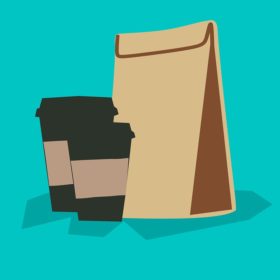
I travel a lot, sometimes more than I would like. I travel both by plane and car, and to areas where grocery stores are nowhere to be found. Which means I often can’t find my personal choices of organic foods, and I refuse to compromise on my health. With my biology and chemistry background, I can’t get passed the molecules of the so called “food” often found in convenience stores and off the beaten path places, and what they will do to my body, despite how tasty someone may have designed them to be.
Running a business has been a learning experience, and my schedule can get a little hectic, especially when traveling. This has proven to be a challenge in trying to maintain my healthy diet of whole, natural, and organic foods. Eating on the road doesn’t offer such comforts. But I figure I need to do my best, since I can either pay to maintain my health now, or I can pay a lot more for it later (in medical care). At the same time, with my schedule being just a tad on the busy side, it is even more important for me to eat healthy, so that my body has the nourishment that it needs to maintain this schedule.

I decided to share some of the things that have been successful for me in maintaining my health while on the run. I have been traveling so much lately that sometimes I wake up and I’m not sure what city I’m in. So I had to figure out how to both pack a lunch for my 16 hour days, and also for the road, or on the plane. I think my current schedule is exactly why convenience stores became so popular. There is just a need for convenience sometimes.

Unfortunately, convenience stores hardly offer anything in the way of health. Even the half and half for the coffee will often be filled with unnecessary ingredients, all for the purpose of long term stability. It seems if I ever do find anything in a convenience store that offers a health return, it turns out to be quite the financial investment. I once paid over $18 for a small piece of organic beef jerky. But now, after years of traveling, I have learned some tricks of the trade.
So here they are, my tips on helping you maintain a healthy diet while traveling. I travel both by car and plane, so that’s where most of these tips come from. Please note, every product I list here I actually personally use/eat. While I don’t always order from Amazon, often I do, because on the road, sometimes it’s easier to have something shipped to my hotel room especially when I don’t have a rental car to take me to the store that carries what I need.
Also, I am aware that many of the products I am listing are not certified organic. I have found this to be a a matter of weighing the pros and cons. For instance, I can find organic dehydrated blueberries, but they all have added sugar, which I do not want. So the only dehydrated blueberries that I can find that do not have added sugar are not listed as organic, but also don’t have any additional ingredients. I also choose products based on the criteria that they are not processed in a facility that could prove dangerous to my family, such as a facility that also processes peanuts. This is just my disclaimer, as my food options/choices will be different from yours. I am merely posting what I learned, and sharing what I have discovered. These suggestions may or may not work for you, only you will know.
1. Start with a good lunch bag. This might seem like a no brainer, but I hardly see anyone that has an actual quality lunch bag. I mean one of those bags where you can fit a full days worth of food, your forks, spoons, knives, some napkins, quick snacks like food bars, etc. I personally use one of these eBags Crew Coolers that I found on amazon and really like it, it doubles as my purse. I’ve been using it for over three years now and it holds enough food for my long days, and also for my traveling days. Plus I keep a set of disposable cutlery for when I get on the plane (you wouldn’t believe how many forks were confiscated by the TSA before I figured out I can use plastic – and now I’ve upgraded to bamboo).
This bag has enough pockets to keep a variety of food items and accessories, which I’ll talk about more below. And, even though the instructions don’t say it’s okay to do this, I have actually emptied this bag, opened all the zippers, and placed it in my dishwasher when I noticed the travel grime accumulating. Lastly, I have never had anyone comment negatively on bringing my lunch-bag to conferences or other events. I’ve actually had many people comment how smart it is of me to pack my own food rather than paying the overpriced prices for the low quality food available at the event.
If a medium sized lunchbag and ice aren’t an option, pack foods that don’t require refrigeration. I recently discovered and started to carry Wild Zora foods, these are great for travel and I have become quite dependent on these.
2. Pack extra. I over pack. I learned this the hard way. I once packed enough snacks for just a few hour drive, only to be stuck for over eight hours due to an unexpected snow storm that caught everyone by surprise and resulted in a huge mess that held up traffic for hours. By the time I got through I was starving, and could care less what it was I was shoving into my tummy. So now I pack extra. I just make sure to have a couple ice packs in my lunch bag, and if I don’t eat it, the food goes back in the fridge that evening. You can bring frozen ice packs in your carry-on luggage, just make sure they are still frozen by the time you go through security. (I once had TSA so focused on making sure that my ice packs were still frozen, that they completely missed my folding knife that was in my bag that I forgot I had in there – I discovered when I was unpacking in my hotel room and had to think back to how I got through security, and realized it was the ice packs that distracted them – I don’t recommend this, just sharing what happened. I feel so much safer TSA, thank you for making sure we are all safe from half frozen ice packs.)
3. Pack a variety of food choices, not just what you think you will eat that day, especially when traveling. Eating on the run can be stressful, so sometimes we choose unhealthy choices. I try to fill my bag with healthy snacks/foods, but also know that if I’m stressed, tired, and cranky, I’m going to reach for the junk food over the healthy food. So I found a solution, and that is to have some healthier junk food in my bag so I’m not tempted to buy it at a convenience store, or at an overpriced airport.
4. If you’re going to be stuck in a hotel room, there are certainly things you can do to still eat healthy even if your hotel room doesn’t accommodate cooking options or a refrigerator. I once stayed in a hotel room for two months that literally had nothing but a Keurig coffee maker and a television, which I didn’t watch. Not even a fridge or a microwave. What did I do? First, I went to the closest store I could find, and bought a cooler, like one of these camping coolers:
Then I unpacked my electric 5th burner out of my suitcase. Yes, you can have these in your checked luggage, my 5th burner has been all over the world and in more hotel rooms than I can remember. You can probably get some fancy ones, but my ten dollar 5th burner has done me well over the years, and I don’t see a reason to spend more on one that may one day get lost in my checked luggage. So this one has worked just fine for me:
Next was the difficult part: finding cookware that isn’t too heavy, so it doesn’t make my luggage go over the typical 50lb weight limit, but is still healthy, meaning stainless steel. I bought this set back in the day when it was still $20 (it’s about $50 at the time of this writing), and while not the greatest quality, it has served me well in the last three years. It is very light weight, and inexpensive enough where I won’t cry if i lose it. So perfect for travel.
Of note, I didn’t pack the whole set. I pick whatever pieces I think I will need, and generally only bring one lid. Then I grab some Bamboo cooking utensils and throw in my suitcase as well.
So here’s how I managed in a hotel room with no microwave or refrigerator. I filled my cooler with free ice from the ice machine; a pain to do every morning, but I got into a routine. Each evening, I would drain the cooler into my shower (yeah, that hotel didn’t even have a tub – and I had to stay there for two months!). The cooler filled with ice was more than enough to keep my groceries cool. My yogurt survived just fine, and my veggies had no issues. Since I couldn’t really freeze raw meat, I cooked my chicken as I bought it, and stored the cooked meat in the cooler to keep cool, and made sure to eat it within three days of cooking. I had no problems with this, other than spending more time in my room tending to my groceries than I would have liked. But for my health, it was worth it, and in the long run I actually saved a lot of money rather than eating out. I did the math, and even with the high price of organic broccoli, I saved a lot of money cooking my meals in my hotel room compared to what I would have spent if I would have gone out to eat for just dinner every night. Doing dishes in a bathroom sink was not so fun, but again, a minor price to pay for health.
I used the 5th burner and the few pots I brought to cook all my meals and used the cooler as a refrigerator to store my left overs. I did pack a set of glass storage containers and invested in Ziploc bags. (I don’t like using plastic, so I ended up buying more glass storage containers after about a week, which doubled as a great way to pack my daily lunch).
I realized that I forgot to bring my favorite ingredient in all my foods. I started bringing my own salt when I realized that salts available in restaurants were usually low quality without any information on their source, or added ingredients. and yes, I’m a saltoholic.
When my trip was over, I was able to pack all my pots and pans in my suitcases, and filled them with clothes, while the glassware I put in my carry-on luggage, and protected with more clothing (and crossed my fingers that they don’t make me check my 2nd carry-on when the flight was full). I donated the cooler to a thrift store, though realized I probably could have tried to sell it as new as it was.
5. Buy your food options ahead of time, and choose dried goods. During my travels, especially to foreign countries, I found the availability of healthy options such as cherries, blueberries, or even nuts that are peanut free is almost impossible. Also, I’ve been diverted to countries I wasn’t expecting to be in, that did not offer food that listed ingredients in a language I could understand; so I was not able to figure out what is in a product, or if it was safe for me to eat. As a result I started buying these items in bulk, and packing them ahead of time. I generally don’t have issues at the airport security, now that I’ve learned how to pack.
The first time I packed my dehydrated blueberries and cherries I got flagged, even though I was TSA pre-check. TSA had to examine my food, and put whatever powder they do on it to test it for explosive material. After they covered my food packaging with who knows what, I threw it away, and asked how I can prevent that in the future. They gave me an amazing tip: if you have dense foods, don’t put them all together as it flags their x-rays, so separate them throughout your bag. Once I started buying in smaller packages, and not keeping them all in one corner together, I’ve had no problems.
I also really love having a quick protein bar for a snack, especially when either driving or on the plane. When driving, I don’t really like to stop to pull over, so having a quick snack to eat that isn’t messy, and is easy and not distracting is helpful. I also like to whip out my food bar when on the plane and everyone else is being served corn syrup based crups (crappy nuts, get it? Okay, corny I know, literally).
Of the Rx bars, the mint happens to be my favorite (**update, I stopped eating these as they had a peanut contamination recall so I switched to the Wild Zora food bars). Regarding the Primal Kitchen food bars, just a warning, those are hard to chew, and are a little pricey, but for the protein to carb ration, I’m trying not to complain.
6. Not everything has to be pre-packaged. There are healthy fresh snacks you can eat while on the road, that don’t require ordering ahead of time or extra processing, or are usually easily found in a grocery store. Some of my favorite snacks include:
- Almonds – buy in bulk and place serving sizes in smaller packaging.
- Baby carrots.
- Fruits such as grapes.
- Beef jerky (grass fed, and without any harmful ingredients like nitrates or MSG).
- Yogurt (I prefer Greek style for the higher protein content).
- Hard boiled egg – you can make a batch easily ahead of time. Hard boiled eggs store well in the fridge (or carry-on cooler with ice-packs).
- Pre-chop your favorite vegetables, and add them to salad mix.
- Pre-made salads, there are now plenty of organic options too.
- Make your own protein shakes, very easy, you don’t even need a blender, just mix some protein powder, purified water, and add your favorite fruit. Need a little sweetener? Add some organic Stevia Extract, this is what I use:
- Make your own trail mix. Mix your favorite nuts such as almonds, dehydrated fruits like cherries or blueberries, and maybe a little broken up chocolate pieces.
- And don’t forget a multi-vitamin. When eating on the road, you often don’t have access to fresh vegetables which will have the best source of nutrients, so you can supplement:
7. Don’t forget coffee. When I stayed in my hotel for two months, I never once used the Keurig. Why? Because I don’t trust it. A lot of plastic parts, and once I read there was an issue with lead in the original models. I just decided that I don’t want to take the chance. Secondly, the free coffee often available in hotel rooms, use tap water, and as I have experienced in several cities now, not all tap water is the same, and coffee made from tap water is like drinking tap water. Plus, I already have the best coffee a foo foo coffee lover that is health minded may want.
First, I use instant coffee. Don’t judge, there are some delicious instant coffees. The one I happen to get is from Europe, plus, the two pack make it one of the most affordable coffees that are also on the (relatively) healthier side (though not organic, unfortunately):
And yes, I said foo foo coffee. How? Very simple. I make sure my coffee water is not too hot, and add my coffee, then I add a scoop of favorite protein powder. (***update: Due to my decision to stop buying products with natural flavors, I have cut out the protein powder because it has added natural flavors. I now drink my coffee with a scoop of stevia instead.)
Couple of things about protein powder:
I. If you are flying, make sure it is sealed. It often comes through on x-rays as very granular, so they need to see it. I’ve never had anyone at TSA have a problem with my protein powder, but when containers are already opened, TSA likes to look inside. Yes, that one went in the trash. So I always have an unopened bag in my carry-on luggage, or if opened, I try to leave it outside the carry-on bag so they can see what it is without handling it.
II. If your water is too hot, it will burn the protein powder. It is made from milk, so temperature is something to consider. Lastly, I used to use a blender to mix, but traveling has been a pain, so I just stir really well. This seems to work just fine, especially on the go.
Also, if you can’t tolerate milk-sourced products, you can try an egg based protein powder. (***Note, I now buy the unflavored protein powder and add my own stevia since it seems all protein powders use natural flavors).
8. Just a busy schedule? Plan your meals ahead of time. I actually spend a good portion of one day a week of just prepping meals ahead of time, and putting them in the freezer. Then during the week, I just grab, heat, and eat. There was a time when I actually thought I was spending too much time in the kitchen, but then I did a time comparison of how long it actually takes. A friend of mine wanted to grab some quick food to go, so she left my place about the same time as I started chopping up vegetables for my nightly dinner, except this time, I was making a huge batch. It was the same recipe you can read about in my article You had what for Dinner?
By the time she came back, I had the veggies all chopped up and almost finished cooking. By the time she finished eating her meal, I had distributed my veggies among six storage containers and one bowl to eat now. Then three containers went in the fridge and three in the freezer. I had just made dinner for seven nights for myself in just a little more time that it took my friend to pick up, and pay someone else, for one meal. In her defense, my cooking time doesn’t include time taken to go to the grocery store.

9. Make it a routine. If you don’t already pack all your own food, then this will be a habit you will need to work on developing. While good habits are hard to develop, the good news is, this habit will become not just routine, but the preferred method to eat when you see how good you feel when making healthy choices when eating on the run, and how much money you actually save. Sure, the initial investment might cost a little up front, but it lasts over the years, and most importantly, there’s something that you just can’t put a price tag on, and that’s your health.
For Health,
Tober
Nature's Complement is a participant in the Amazon Services LLC Associates Program, an affiliate advertising program. If you purchase products on Amazon through any of our affiliate links, we get a small percentage of the transaction, at no extra cost to you. We spend a lot of time writing the articles on this site, and all this information is provided free of charge. When you use our affiliate links, you support the writing you enjoy without necessarily buying our products. (However we would appreciate if you would do that too!) Thank you for helping to support our work, however you choose to do so.
These statements have not been evaluated by the Food and Drug Administration. This information and/or products are not intended to diagnose, treat, cure or prevent any disease.




